
On Monday morning, there was a special Nobel Laureate Tree Planting Ceremony that invited Professors Danny Shechtman and Alvin Roth to plant trees along the Nobel Prize Laureates Avenue in the Lorry Lokey garden at the Technion. Professor Schechtman from the Technion’s Faculty of Materials Science and Engineering was awarded the Nobel Prize for Chemistry in 2011 for his discovery of quasicrystals, and Professor Roth received the 2012 Nobel Prize in Economic Sciences for the theory of stable allocations and the practice of market design.
“I was five years old when I planted my first tree,” said Professor Schechtman . “It was in the Bar Ilan Garden in Ramat Itzhak. The tree is still there. Since then, planting trees always accompanies me with a sense of creativity and joy of making our country greener.”
Professor Roth said that although he didn’t physically plant a tree in his childhood, he remembers donating to the Jewish National Fund -JNF (in Hebrew “Keren Kayemet”) for a tree to be planted in his name in Israel. “Since then, I’ve been searching for this tree on my visits to Israel,” he said. Technion President Professor Peretz Lavie, responded by saying that from now on he will always be able to find his tree here at the Technion, along the Nobel Prize Laureates Avenue.
On Monday evening, the Honorary Doctorate Conferment Ceremony took place at the Churchill Auditorium. The recipients of honorary doctorates were Professor Alvin Roth, for his important contributions to the field of game theory and experimental economics and their application to the design of new economic institutions, Ilan Biran, former Chairman of RAFAEL Armament Development Authority Ltd., Elisha Yanay, former President and General Manager of Motorola Israel and founder of his own company that deals with high-technology, communications and homeland security, Steven Emerson, who has generously supported Birthright Israel and is actively involved with “Stand With Us” (STU) – providing training and support to 40 pro-Israel North American college leaders in their efforts to educate fellow students about Israel and to dispel anti-Israel slurs, Yoram Alster, Alfred Bär, Melvyn Bloom, Daniel Rose, and Professor Jason Speyer.

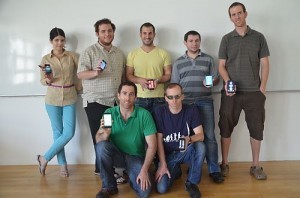 Students at the Technion have developed software that enables the visually impaired to use smartphones by vocally announcing the key the user is pressing. Dialing, texting and setting the smartphone alarm clock are daily operations that most people perform very easily. The world of the visually impaired is completely different since they are unable to use touchscreen phones and so most of these operations are unavailable to them.
Students at the Technion have developed software that enables the visually impaired to use smartphones by vocally announcing the key the user is pressing. Dialing, texting and setting the smartphone alarm clock are daily operations that most people perform very easily. The world of the visually impaired is completely different since they are unable to use touchscreen phones and so most of these operations are unavailable to them.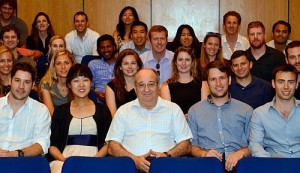 Student delegation from MIT’s School of Management visits the Technion
Student delegation from MIT’s School of Management visits the Technion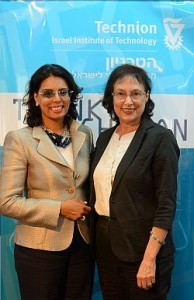 Meets with Technion President Prof. Peretz Lavie and Prof. Miriam Erez, recipient of the Israel Prize
Meets with Technion President Prof. Peretz Lavie and Prof. Miriam Erez, recipient of the Israel Prize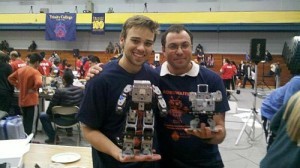 The engineer who chose to study Education in Science and Technology in the Views Program and teach at a special school
The engineer who chose to study Education in Science and Technology in the Views Program and teach at a special school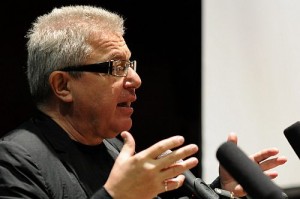 Four world-leading architects participated in the Waterfront Conference that took place at Technion last week. They were Daniel Libeskind, who is developing the master plan for the World Trade Center, landscape architect Professor Martha Schwartz from Harvard University, Vanessa Kassabian from the Norwegian architecture firm Snøhetta that designed the Opera House in Oslo, and Gregg Pasquarelli from SHoP architects, responsible for planning the Barclays Center at Atlantic Yards in Brooklyn, a two-mile esplanade and park along the East River Waterfront of Manhattan.
Four world-leading architects participated in the Waterfront Conference that took place at Technion last week. They were Daniel Libeskind, who is developing the master plan for the World Trade Center, landscape architect Professor Martha Schwartz from Harvard University, Vanessa Kassabian from the Norwegian architecture firm Snøhetta that designed the Opera House in Oslo, and Gregg Pasquarelli from SHoP architects, responsible for planning the Barclays Center at Atlantic Yards in Brooklyn, a two-mile esplanade and park along the East River Waterfront of Manhattan.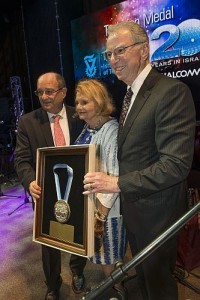 Dr. Irwin Jacobs was given the Institute’s greatest recognition at an anniversary ceremony marking 20 years of Qualcomm activities in Israel
Dr. Irwin Jacobs was given the Institute’s greatest recognition at an anniversary ceremony marking 20 years of Qualcomm activities in Israel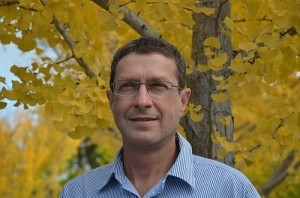 Technion scientists developed a new class of photonic materials, named Spin-Optical Metamaterial, which is based on nano-antennas controlling radiative modes assisted through the spin of light. The discovery will enable the realization of new optical surface components on the nano-scale (metasurfaces), which are based on the fundamental elements of the optical antenna’s material (optical meta-atoms), and symmetry properties – the breaking of symmetry of the photonic structure. By designing the metasurface symmetry properties with space-variant oriented anisotropic nano-antennas, it is possible to control the light-matter interaction and to design the radiative and surface optical modes.
Technion scientists developed a new class of photonic materials, named Spin-Optical Metamaterial, which is based on nano-antennas controlling radiative modes assisted through the spin of light. The discovery will enable the realization of new optical surface components on the nano-scale (metasurfaces), which are based on the fundamental elements of the optical antenna’s material (optical meta-atoms), and symmetry properties – the breaking of symmetry of the photonic structure. By designing the metasurface symmetry properties with space-variant oriented anisotropic nano-antennas, it is possible to control the light-matter interaction and to design the radiative and surface optical modes.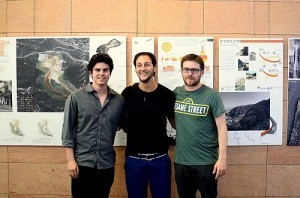 Students Eitai Vander, Yehonatan Hochman and Yogev Bitan, studying landscape architecture at Technion, won first place in a planning competition for renovating the Nesher Quarry. The prize: NIS 10,000
Students Eitai Vander, Yehonatan Hochman and Yogev Bitan, studying landscape architecture at Technion, won first place in a planning competition for renovating the Nesher Quarry. The prize: NIS 10,000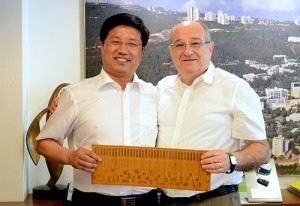 Top Chinese students will receive scholarships up to $35,000 per year to study at the Technion, Weizmann Institute and the Hebrew University
Top Chinese students will receive scholarships up to $35,000 per year to study at the Technion, Weizmann Institute and the Hebrew University